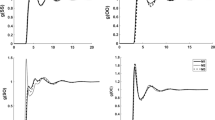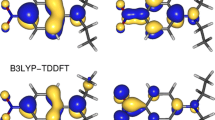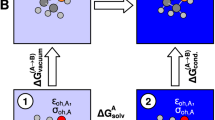Abstract
Forty ionic molecules are studied by DFT (B3LYP, B3P86), MP4 with different basis sets using the PCM/UAHF model within the self-consistent reaction-field method to assess solvent effects. For these molecules, the solvation free energies (ΔG sol) in water and the dipole moments in vacuoas well as in water are obtained. By comparing the calculated values of ΔG sol with experimental values and molecular simulation results, it is found that the ΔG sol values generated by the DFT method are in better agreement with experimental values. Moreover, especially for the B3LYP/6-31+G∗ level, the results of both ΔG sol and dipole moments are more accurate considering the lower computational cost. It can be noted that the dipole moments of solutes in water show some increase relative to those in vacuo.
Similar content being viewed by others
References
Tolosa, S., Sansón, J.A., Hidalgo, A.: Molecular dynamics simulation of aqueous solutions using interaction energy components: application to the solvation gibbs energy. J. Solution Chem. 34, 407–414 (2005)
Zamanakos, G.: A fast and accurate analytical method for the computation of solvent effects in molecular simulations. Ph.D. Dissertation, California Institute of Technology Pasadena, California (2002)
Onsager, L.: Electric moments of molecules in liquids. J. Am. Chem. Soc. 58, 1486–1493 (1936)
Rivail, L., Rinaldi, D.: Molecular polarizability and dielectric effect of medium in the liquid phase. Theoretical study of the water molecule and its dimers. Theor. Chim. Acta 32, 57–70 (1973)
Tapia, O., Goscinski, O.: Self-consistent reaction field theory of solvent effects. Mol. Phys. 29, 1653–1661 (1975)
Tomasi, J., Persico, M.: Molecular interactions in solution: an overview of methods based on continuous distributions of the solvent. Chem. Rev. 94, 2027–2094 (1994)
Truong, T.N., Stefanovich, E.V.: A new method for incorporating solvent effect into the classical, ab initio molecular orbital and density functional theory frameworks for arbitrary shape cavity. Chem. Phys. Lett. 240, 253–260 (1995)
Ruiz-López, M.F., Bohr, F., Martins-Costa, M.T.C., Rinaldi, D.: Studies of solvent effects using density functional theory. Co-operative interactions in H3N⃛HBr proton transfer. Chem. Phys. Lett. 221, 109–116 (1994)
De Angelis, F., Sgamellotti, A., Cossi, M., Rega, N., Barone, V.: A plane wave implementation of the polarizable continuum model. Chem. Phys. Lett. 328, 302–309 (2000)
Jeon, J., Kim, H.J.: A continuum reaction field theory of polarizable, nondipolar, quadrupolar solvents: Ab Initio study of equilibrium solvation in benzene. J. Solution Chem. 30, 849–860 (2001)
Miertu, S., Scrocco, E., Tomasi, J.: Electrostatic interaction of a solute with a continuum. A direct utilization of ab initio molecular potentials for the prevision of solvent effects. Chem. Phys. 55, 117–129 (1981)
Cossi, M., Barone, V., Cammi, R., Tomasi, J.: Ab initio study of solvated molecules: a new implementation of the polarizable continuum model. Chem. Phys. Lett. 255, 327–335 (1996)
Mennucci, B., Cossi, M., Tomasi, J.: A theoretical model of solvation in continuum anisotropic dielectrics. J. Chem. Phys. 102, 6837–6845 (1985)
Cossi, M., Mennucci, B., Tomasi, J.: Solute–solvent electrostatic interactions with non-homogeneous radial dielectric functions. Chem. Phys. Lett. 228, 165–170 (1994)
Cammi, R., Tomasi, J.: Analytical derivatives for molecular Solutes. II. Hartree-Fock energy first and second derivatives with respect to nuclear coordinates. J. Chem. Phys. 101, 3888–3897 (1994)
Cammi, R., Cossi, M., Mennucci, B., Tomasi, J.: Solvent effects on static and dynamic polarizability and hyperpolarizabilities of acetonitrile. J. Mol. Struct. 436, 567–575 (1997)
Cammi, R., Frediani, L., Mennucci, B., Tomasi, J.: Calculation of nonlinear optical susceptibilities of pure liquids within the polarizable continuum model: the effect of the macroscopic nonlinear polarization at the output frequency. J. Mol. Struct. (Theochem.) 633, 209–216 (2003)
Tñón, I., Ruiz-Lopez, M.F., Rinaldi, D., Bertr´n, J.: Computation of hydration free energies using a parameterized continuum model: study of equilibrium geometries and reactive processes in water solution. J. Comput. Chem. 17, 148–155 (1996)
Wong, M.W., Wiberg, K.B., Frisch, M.J.: Solvent Effects. 2. Medium effect on the structure, energy, charge density, and vibrational frequencies of sulfamic acid. J. Am. Chem. Soc. 114, 523–529 (1992)
Mikkelsen, K.V., Cesar, A., Agren, H., Jensen, H.J.A.: Multiconfigurational self-consistent reaction field theory for nonequilibrium solvation. J. Chem. Phys. 103, 9010–9023 (1995)
Wong, M.W., Frisch, M.J., Wiberg, K.B.: Solvent Effects. 1. The mediation of electrostatic effects by solvents. J. Am. Chem. Soc. 113, 4776–4791 (1991)
Aleman, C., Galembeck, S.E.: Solvation of chromone using combined discreterSCRF models. Chem. Phys. 232, 151–159 (1998)
Jezierska, A., Panek, J., Ryng, S.: DFT study of a novel lead structure in the isoxazole heterocyclic system. J. Mol. Struct. (Theochem.) 636, 203–214 (2003)
Fortunelli, A., Tomasi, J.: The implementation of density functional theory within the polarizable continuum model for solvation. Chem. Phys. Lett. 231, 34–39 (1994)
Hall, R.J., Davidson, M.M., Burton, N.A., Hillier, I.H.: Combined density functional, self-consistent reaction field model of solvation. J. Phys. Chem. 99, 921–924 (1995)
Namazian, M.: Density functional theory response to the calculation of electrode potentials of quinines in non-aqueous solution of acetonitrile. J. Mol. Struct. (Theochem.) 664, 273–278 (2003)
Pascual-Ahuir, J.L., Silla, E., Tuñón, I., GFPOL: An improved description of molecular surface. III. A new algorithm for the computation of a solvent-excluding surface. J. Comput. Chem. 15, 1127–1138 (1994)
Cossi, M., Mennucci, B., Cammi, R.: Analytical first derivatives of molecular surfaces with respect to nuclear coordinates. J. Comput. Chem. 17, 57–73 (1996)
Floris, F.M., Tomasi, J., Pascual-Ahuir, J.L.: Dispersion and repulsion contribution to the solvation energy: refinements to a simple computational model in the continuum approximation. J. Comput. Chem. 12, 784–791 (1991)
Caillet, J., Claverie, P.: On the conformational varieties of acetylcholine in the crystals of its halides. Acta Crystallogr. B 34, 3266–3272 (1978)
Pierotti, R.A.: A scaled particle theory of aqueous and nonaqueous solutions. Chem. Rev. 76, 717–726 (1976)
Becke, A.D.: Density-functional Thermochemistry. III. The role of exact exchange. J. Chem. Phys. 98, 5648–5652 (1993)
Lee, C., Yang, W., Parr, R.G.: Development of the Colle–Salvetti correlation-energy formula into a functional of the electron density. Phys. Rev. B 37, 785–789 (1988)
Perdew, J.P., Wang, Y.: Accurate and simple analytic representation of the electron-gas correlation energy. Phys. Rev. B 45, 13244–13249 (1992)
Barone, V., Cossi, M., Tomasi, J.: A new definition of cavities for the computation of solvation free energies by the polarizable continuum model. J. Chem. Phys. 107, 3210–3221 (1997)
Frisch, M.J., Trucks, G.W., Schlegel, H.B., Scuseria, G.E., Robb, M.A., Cheeseman, J.R., Zakrzewski, V.G., Montgomery, J.A. Jr., Stratmann, R.E., Burant, J.C., Dapprich, S., Millam, J.M., Daniels, A.D., Kudin, K.N., Strain, M.C., Farkas, O., Tomasi, J., Barone, V., Cossi, M., Cammi, R., Mennucci, B., Pomelli, C., Adamo, C., Clifford, S., Ochterski, J., Petersson, G.A., Ayala, P.Y., Cui, Q., Morokuma, K., Malick, D.K., Rabuck, A.D., Raghavachari, K., Foresman, J.B., Cioslowski, J., Ortiz, J.V., Baboul, A.G., Stefanov, B.B., Liu, G., Liashenko, A., Piskorz, P., Komaromi, I., Gomperts, R., Martin, R.L., Fox, D.J., Keith, T., Al-Laham, M.A., Peng, C.Y., Nanayakkara, A., Gonzalez, C., Challacombe, M., Gill, P.M.W., Johnson, B., Chen, W., Wong, M.W., Andres, J.L., Gonzalez, C., Head-Gordon, M., Replogle, E.S., Pople, J.A.: Gaussian 98, Revision A.7, Gaussian, Inc., Pittsburgh PA (1998)
Wang, J., Wang, W., Huo, S., Lee, M., Kollman, P.: Solvation model based on weighed solvent accessible surface area. J. Phys. Chem. B. 105, 5055–5067 (2001)
Lide, D.R.: Handbook of Chemistry and Physics, 72th edn. CRC Press, Boca Raton (1991)
Author information
Authors and Affiliations
Corresponding author
Rights and permissions
About this article
Cite this article
Wang, Y., Cheng, X., Yang, X. et al. DFT Study of Solvent Effects for Some Organic Molecules Using a Polarizable Continuum Model. J Solution Chem 35, 869–878 (2006). https://doi.org/10.1007/s10953-006-9034-0
Received:
Accepted:
Published:
Issue Date:
DOI: https://doi.org/10.1007/s10953-006-9034-0




